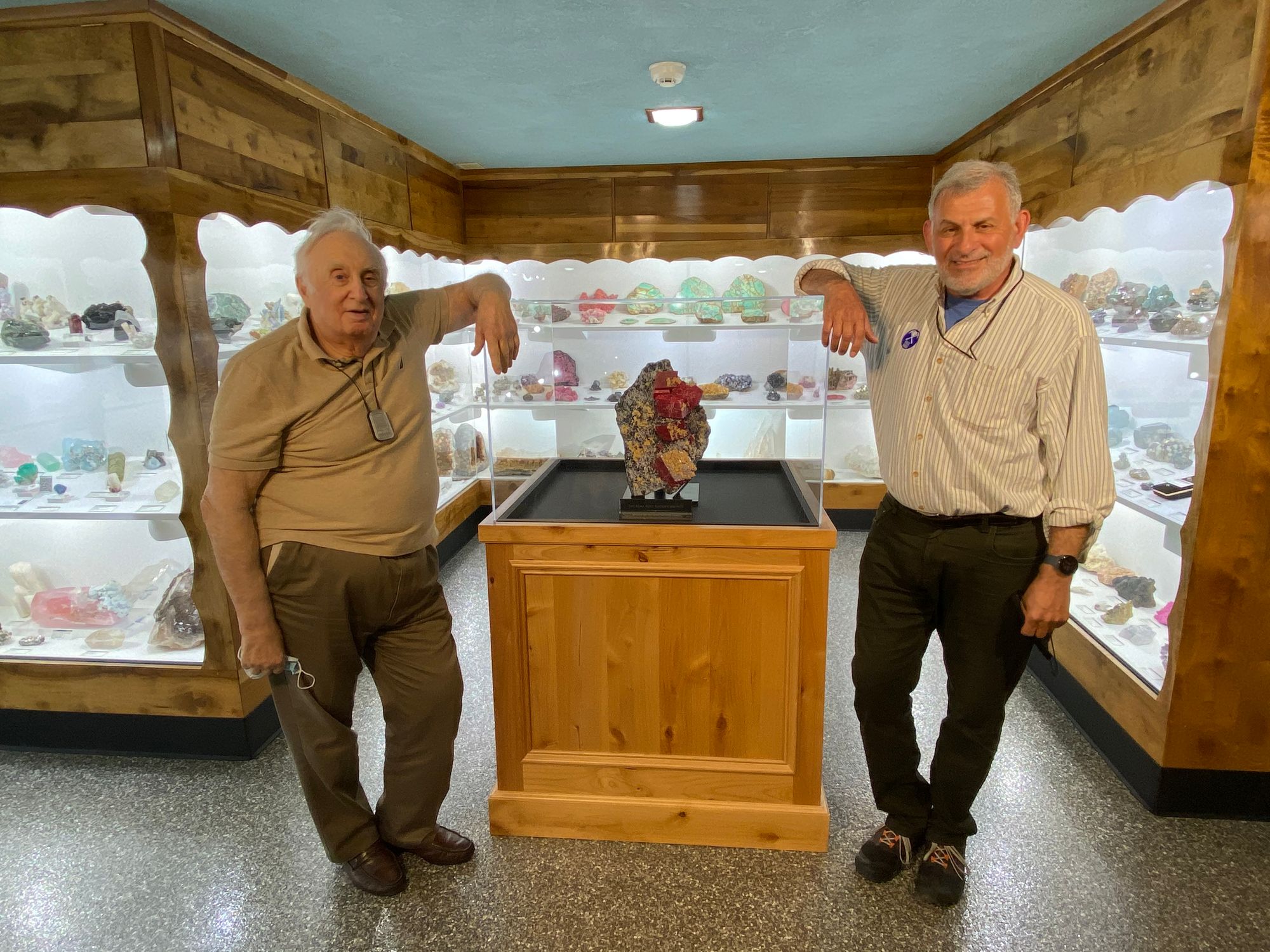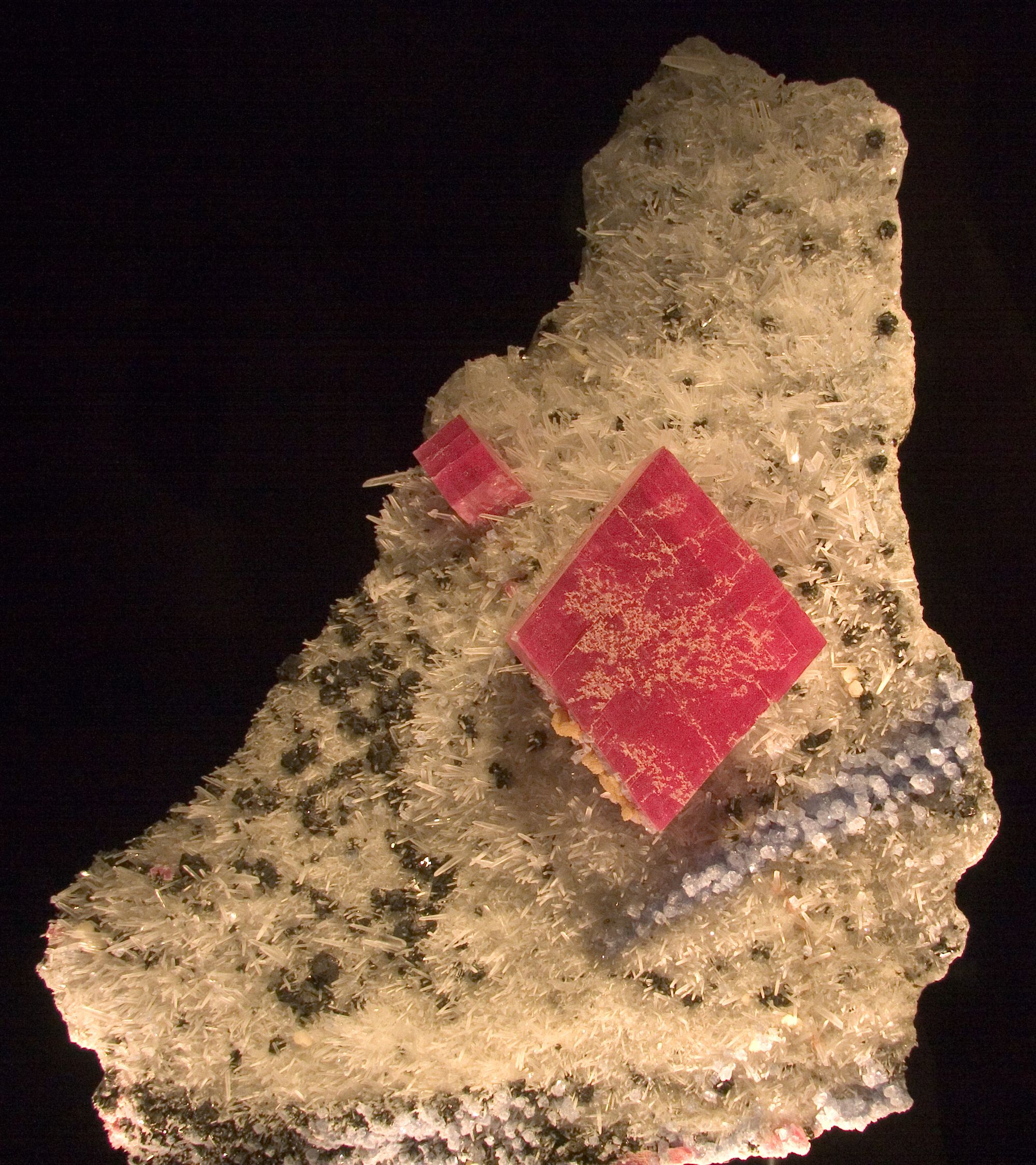Rhodochrosite Royalty from the Sweet Home Mine, CO
by Ken Rock, MSDC Editor

The Sweet Home Mine
As silver mines go, the Sweet Home Mine was a failure. Based solely on its unimpressive silver output, the Sweet Home should have faded into obscurity and abandonment a century ago, joining countless other mines that became nothing more than collapsed portals and flooded workings. Discovered in 1873 and developed for its silver ore, the mine was intermittently worked with only moderate success as a silver mine before closing in 1967. Thanks to some unique and fortuitous geology and some investors willing to take risks, the Sweet Home Mine later became known for strikingly beautiful, red rhodochrosite crystals which are acknowledged as the world’s finest. This article highlights three of the most spectacular rhodochrosite specimens known, all of which originated from the Sweet Home Mine.
An Investment for the Sole Purpose of Specimen Mining
In 1991, the Sweet Home Mine was reopened, not as a silver mine, but as a mine for rhodochrosite specimens. Sweet Home Rhodo, Inc. was formed by a consortium of investors, led by Bryan and Kathryn Lees of Collector’s Edge Minerals, Inc., in Golden, Colorado. The team included Marty Zinn, Gene Meieran, and John Lucking who were intrigued by the concept of standalone specimen mining and agreed to lease the property.
The consortium invested a reported $300,000 to lease and rehabilitate old mine infrastructure to start production (Wenrich and Lees, 2022) of specimens of cherry-red, gemmy rhodochrosite. With persistence and some additional borrowing, Sweet Home Rhodo was able to continue mining and found pockets with “museum-grade” rhodochrosite, along with beautiful fluorite, tetrahedrite-tennantite, sphalerite, pyrite, and huebnerite.
Continued persistence ultimately would lead to the unprecedented discovery of the world’s finest rhodochrosite specimens, including all three of the specimens described here, as well as the “Crystal Wall,” a 7-foot by 8-foot reconstructed pocket, sprinkled with hundreds of deep red, translucent rhodochrosite crystals from the Sweet Home Mine that now resides in the Denver Museum of Natural History.
Alma Rose
The Alma Rose is one of the finest specimens to emerge from the mine. It is now on exhibit at the Rice Northwest Rock and Mineral Museum in Hillsboro, Oregon. My wife and I were fortunate to meet a mineral collecting friend, Gene Meieran, at the museum in May 2021 to get a personal tour from Gene who has donated numerous specimens to this wonderful, small museum. Recently the museum hired the ex-curator of the Lyda Hill Gem and Mineral Hall of the Perot Museum as Executive Director.
The Alma Rose is composed of a cluster of three-inch deeply colored rhombs that are interlocked to form a grouping of crystals approximately six inches across. Not only is each rhodochrosite crystal is sharp enough to be enjoyed individually, but the positioning of the crystals is such that the overall effect is simply stunning! The rock matrix is completely covered and hidden by bright small quartz crystals. Among all the quartz crystals are small contrasting dark sulfide crystals and a scattering of small colorful fluorite cubes.
To add a finishing touch, the final solutions released a scattering of small crystallized fine pale yellow siderite sprays which developed randomly on and around the rhodochrosite. These crystals provide contrast and do not detract from the overall beauty of the specimen.
Alma King
In 1992, the Sweet Home produced the largest rhodochrosite single crystal specimen known from the mine, the legendary Alma King, almost 6 inches on a side. The Alma King sites on an acicular (a needle-like crystal form) quartz matrix more than 2 feet long, sprinkled with purple fluorite crystals. The Coors Foundation later bought the Alma King and donated it to the Denver Museum of Nature & Science for display.

Finding it was the event of a lifetime, Bryan Lees recalled. “It’s not something you expect. We didn’t know we were going to find something like that — nobody knew.” As it happened, a camera crew from the Denver Nature and Science Museum was at the mine that very day to shoot footage of the blasting work. Little did they know they would capture footage of the world’s premier rhodochrosite specimen as it saw light for the first time. “If you go down and see the Alma King at the museum you can watch a little clip of me pulling it out,” Lees said. “It’s 100 percent real. It’s not staged.”

Alma Queen
The third member of the rhodochrosite royalty produced by the Sweet Home Mine, the Alma Queen, was found in 1966 by John Soules, a Texan, who had leased the mine during this period. In late 1966, Soules’ crew drilled into a pocket of specimens that would redefine collector-quality rhodochrosite. The now famous Alma Queen, later proclaimed the world’s finest mineral specimen, was among the specimens in Soules’ pocket.

This amazing specimen was first purchased in 1967 by Denver mineral collectors George Robertson for $2,500. Later it was purchased by Peter Bancroft who named it the "Alma Queen." It passed through a few more collections before it ended up in the Perkins Sams collection. In 1986 the Houston Museum of Natural Science purchased the Sams collection and the along with it the "Alma Queen." It was a apparently broken while being moved around the museum, but luckily they were able to repair it.
In its time, the Sweet Home was a prolific source of high-quality rhodochrosite and of pride in the tiny town of Alma. The Alma King is still considered by many to be the finest specimen of rhodochrosite in the world. It’s also the reason why the gem was made Colorado’s state mineral in 2002.

Some Comments on the Extraction Process
Just how such perfect, undamaged specimens can be extracted from its rock prison without damage is strong evidence of how far we have progressed in specimen recovery these last decades. Today, with modern tools, such removal of the Alma Rose and its sister minerals, the Alma King and Alma Queen, was accomplished without serious damage to any of the exposed crystals.
The Alma Rose was on a solid rock wall, one side of a crystallized vein. To remove the specimen undamaged, miners used a combination of power drills, diamond saws and hydraulic wedges. The miners were well aware that any serious vibrations of the rock holding the crystals could cause catastrophic damage to the specimen because rhodochrosite has perfect cleavage and any stress might cause crystals to part.
For the Alma Rose, drilling started well away from the open vein, which was first covered to protect it. Holes were drilled all around the wall section encircling the open vein. These served as a guide for the diamond saws that cut deeply into the wall rock. Slowly, the cut openings could be wedged open and more cutting was done to get behind the vein.
Once the entire vein section had been undercut it was broken loose from the wall with its still intact crystals. It could be carefully removed and taken to the specimen preparation lab at Collector’s Edge where trimming excess rock was slowly done, reducing the specimen to a manageable size and weight. Further trimming and shaping were done until the surface was exposed and crystals could be seen in all their beauty. With proper cleaning and shaping the Alma Rose was ready to be displayed.
Report Card
From 1991 to 2004, the Sweet Home Mine produced thousands of rhodochrosite specimens from dozens of colorfully named pockets. Although a detailed chronology of the mining operation is beyond the scope of this article, the names of the pockets include Cash Flow, Bad Luck, Good Luck Rainbow (the source of the Alma King), Museum, Red & Blue, Empty, Pyrite, Heubnerite, Blueberry, Corner, Murphy's, Butterfly, Hedgehog, and Clay.

According to Gene Meieran, the Good Luck Pocket was by far the most beneficial in terms of producing great specimens and of great income for the investors (personal communication). Below is a picture of the famous Blueberry Pocket specimen, the only major specimen found one year before the Good Luck pocket was discovered.

The cumulative value of rhodochrosite specimens produced at the Sweet Home Mine probably exceeds $100 million and the mine is clearly the world’s premier source of fine rhodochrosite. All in all, that’s not a bad record for a “failed” silver mine.
Eventually, all of the known rhodochrosite targets were exhausted and the company faced two options: begin anew with an extensive and expensive exploration and development program, or close the mine. With all of the potential new targets well outside the existing mine workings, Bryan Lees decided that a new venture would risk all the profits that had been gained over the previous 14 years.
In the fall of 2004, the portal was sealed, the old mine tailings were removed, the ground was contoured and reseeded, and the Sweet Home Mine was closed. Today all that remains is one old building as a monument to one of the twentieth century’s greatest specimen-mining adventures. The value of rhodochrosite specimens taken from the Sweet Home mine far exceeds that of most Colorado gold and silver mines; thus making the mine one of the most successful in the history of the state.

Sources and More Information
1) Ken Kucera, The Sweet Home Mine Silver “Failure” To Rhodochrosite Bonanza (1872 – 2022) Mount Bross, Alma Mining District, Park County, Colorado
2) Kimberly Knox and Bryan K. Lees, Gem Rhodochrosite from the Sweet Home Mine, Colorado
3) Jack Queen, Summit Daily, Oct 16, 2017, Colorado gem hunters are back near Alma mine that was once a mother lode of rhodochrosite, the official state mineral
4) Collectors Edge, The Sweet Home Mine, Park County, Colorado
5) Wenrich, K.J., and Lees, B.K., March 7, 2022, PowerPoint presentation on the Sweet Home Mine, Park County, Colorado. DREGS (Denver Region Exploration Geologists’ Society) on-line meeting.
6) Mineralogical Record, Volume 29, Number 4, pp. 1-153 (pictured above). This issue describes the whole project in detail.
